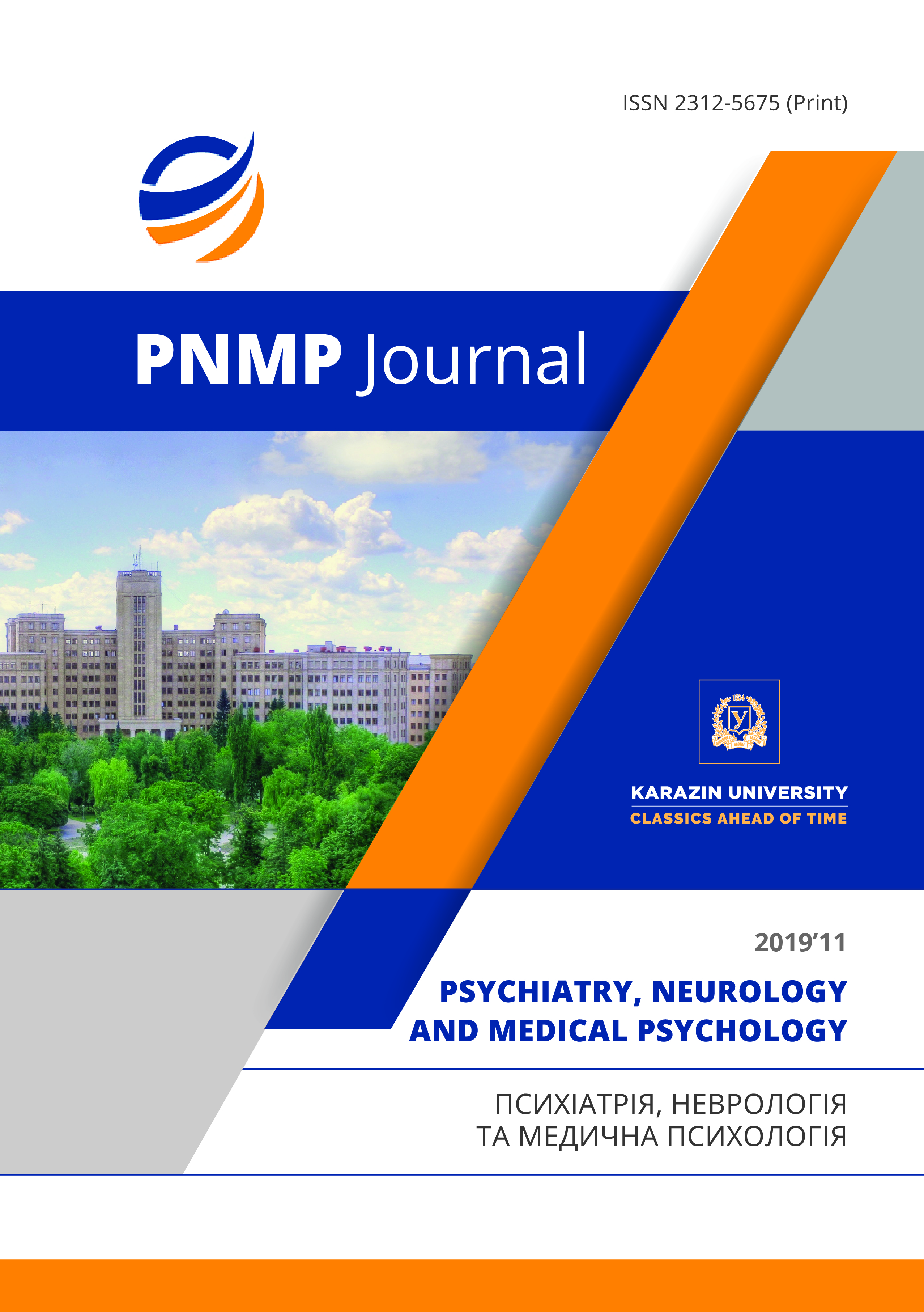Modern view of the pathogenetic mechanisms of the limbic system role in the forming of pain syndromes in pharmacoresistant facial sympathalgia
Abstract
The present work was devoted to pharmacoresistant facial sympathalgia which held one of the frequent places among other neuropatic acute and chronic pain syndromes; they usually characterized by long-term clinical course and severe pain which is resistant to conducted conservative therapy by several pharmaceutical drugs. In this paper the general modern data about the etiopathogenetic mechanisms and the role of limbic system, its other anatomical and physiological parts in the genesis and forming of pain paroxysms in facial sympathalgia were presented. Pharmacoresistant facial sympathalgia differs from the other pain syndromes with more similar and typical localization, the severity of clinical manifestations, the presence of neurological deficit, long-recurrent clinical course, resistance to various treatment methods, both therapeutic and neurosurgical, and different somatic complications. At the autonomic response disturbances, epileptic or paroxysmal focus plays the leading disorganizing role, located mainly in the medial structures of the limbic-reticular complex. It has been established, that the limited convulsive activity in various structures of the limbic-reticular complex is the pathogenesis basis of non-epileptic or painful paroxysms, which does not reach of the formation of morpho-functional epileptic system because of influence of various stabilizing factors. Also it was discussed that in the pathogenetic mechanisms any changes in the functional state of the pain-sensing nociceptive and antinociceptive systems and leading neurotransmitters have played the certain role in pharmacologically resistant facial sympathalgia where glutamate and aspartate are being modulators of the convulsive and neuroplastic brain activity, directly and indirectly participating in the formation of processes of excitation and pain threshold, different neurotoxic processes.
Downloads
References
Alieva H.K. Clinical, physiological and biochemical aspects of the vegetative paroxysms pathology, dissertation PhD, 14.00.13. Moscow, 1989. -212 p. [In Russ.]
Bashmakov M.U. Panic attacks (clinical and psychophysiological investigation), dissertation PhD, 14.00.13. Moscow, 1995, p 132.. [In Russ.]
Berezovskaya A.P., Bukov U.N. Neuropathic pain. Siberian journal. – 2008. – N4.- P. 13-16 . [In Russ.]
Vegetative disorders: clinics, diagnostics, treatment / under the reduction of Vein A.M. Moscow: Medical Information Agency, 2000, p 752. . [In Russ.]
Gaevaya M.A. The peculiarities of the vegetative-vascular paroxysms at posttraumatic cerebral arachnoiditis of different localization, dissertation PhD, 14.00.13. Kharkiv, 200, p 184. . [In Russ.]
Grachev U.V. Paroxysmal trigeminal pain. Journal of neurology and psychiatry 2011, №7, pp 84–87. . [In Russ.]
Grinberg M.S. Neurosurger. Moscow: MedPressInform.- 2010, p 1008.. [In Russ.]
Kruzanovski G.N. Phisiological and pathological pain. Pathogenesis 2005, № 1, P. 14. [In Russ.]
Mumentaler M., Mattle H. Neurology. Moscow: MedPressInform, 2009.- 920 p. .[In Russ.]
Neurology under the redaction of Sammuels M. translation from English; Moscow: Practica, 1997.- 638 p. [In Russ.]
Odinak M.M., Michaelenko A.A., Shustov E.B. Vegetative paroxysms: pathogenesis, diagnostics, treatment. Military and medical journal.- 1996. - №11. - P. 37-45. [In Russ.]
Pavlenko S.S. Pain epidemiology: the review. Neurological journal. – 2009, № 1, P. 41-46. [In Russ.]
Phylin V.I., Tolstoy A.D. Pain encyclopedia. About pain appearing, its reasons and how to get it free. Saint-Petersburg: Flamingo. 1996.- 470 p. . [In Russ.]
Zimbaluk V.I., Tretayak M.A., Sapon M.A. et all The pain problem investigation in the literature of former USSR countries. Ukrainian neurosurgery journal, 2005, №4, P. 4–10.. [In Russ.]
Churukanov M.V., Dorohov E.V. Pharmacoresistance neuropathic pain. Neurology, neuropsychiatry, psychosomatic 2013, №2, P. 84–88. [In Russ.]
Yavorskaya N.P. The pain: from molecular mechanisms till clinical aspects. International Neurological Journal, 2011, №3 (41), P. 130–135.[In Russ.]
Agostoni E. R. Frigerio, P. Santoro Atypical facial pain: clinical considerations and differential diagnosis // Neurol. Sci. – 2005. – № 26. – P. 71–74.
Bahra A., Goadsby P.J. Diagnostic delays and mismanagement in cluster headache // Acta Neurol. Scand. – 2004. – Vol. 109. – P. 175–179.
Bouhassira D., Lanteri-Minet M., Attal N. et al. Prevalence of chronic pain with neuropathic characteristics in the general population // Pain. – 2008. - № 136. – P. 380-387.
Brown M.R., Tache J. Hypothalamic peptides: central nervous system control of visceral function // Fed. Proc. - 1981. - Vol. 40. - P. 2565-2569.
Deborah E. Cluster Headache // Headache: The Journal of Head and Face Pain P. – 2015 – P. 757–758.
Gatchel R.J., McGeary D.D., McGeary C.A. et al. Interdisciplinary chronic pain management (past, present and future) // American psychologist. – 2014. – Vol. 69, №2. – P. 119-130.
Hokfelt T., Bartfai T., Bloom F. Neuropeptides: opportunities for drug discovery // The Lancet Neurology. - 2003. - Vol. 2, №8. - P. 463-472.
Perez H., Pinter A., Numez V. Modulation of GABA effects by endocrine factors in the corpus striatum of the rat // J. Physiol. Proc. - 2000. - Vol. 525. - P. 104P-105P.
Perkin G.D. Neurology in general practice. - The United Kingdom: Dunitz Ltd., 2002. - 90 p.
Reddy P. The clinical potentials of endogenous neurosteroids // Drugs today. - 2002. - №7. - P. 465-485.
Silberstein S.D., Lipton R.B., Dalessio D.J. Wolff's headache and other head pain. - New-York: Oxford Universirty Press, 2001. - 625 p.
Smith H.S., Sang C.N. The evolving nature of neuropathic pain: individualizing treatment // European Journal of Pain. - 2002. - Vol. 6, Suppl. B. - P. 18-24.
The International Classification of Headache Disorders // Cephalalgia. – 2004. – Vol. 24. – P. 9–160.
Weiss A.L., Ehrhardt K.P., Tolba R. Atypical facial pain: a comprehensive, evidence-based review // Curr Pain Headache Rep. – 2017. - № 21 (2). – Р. 8-18.

